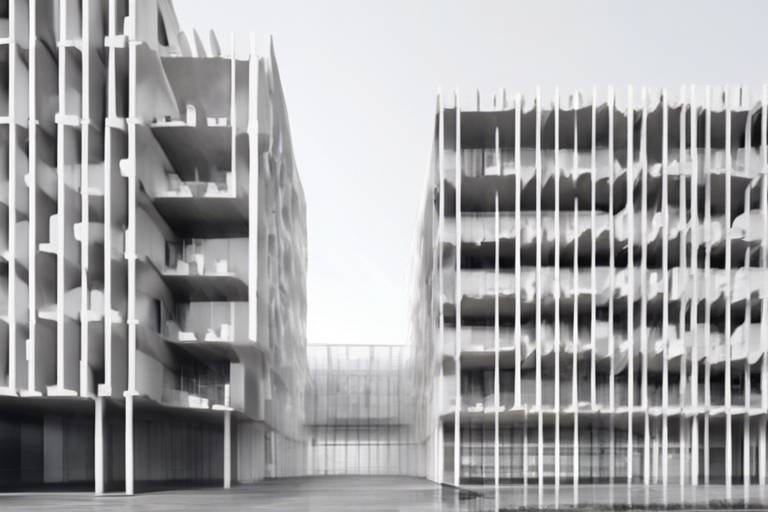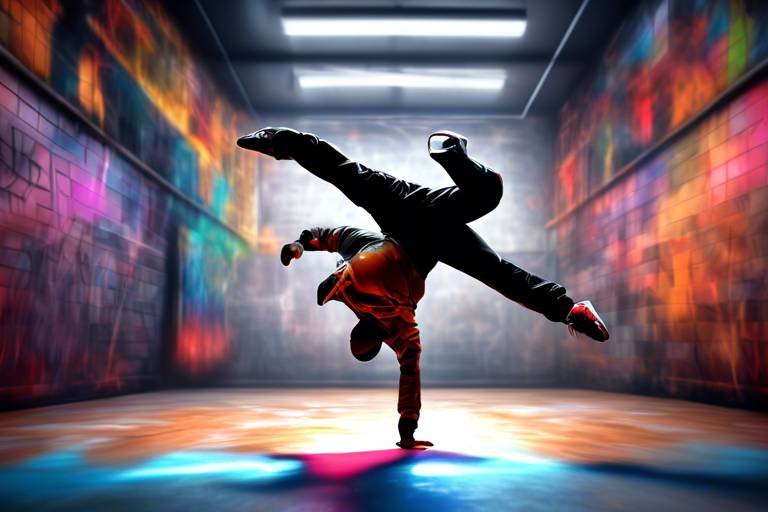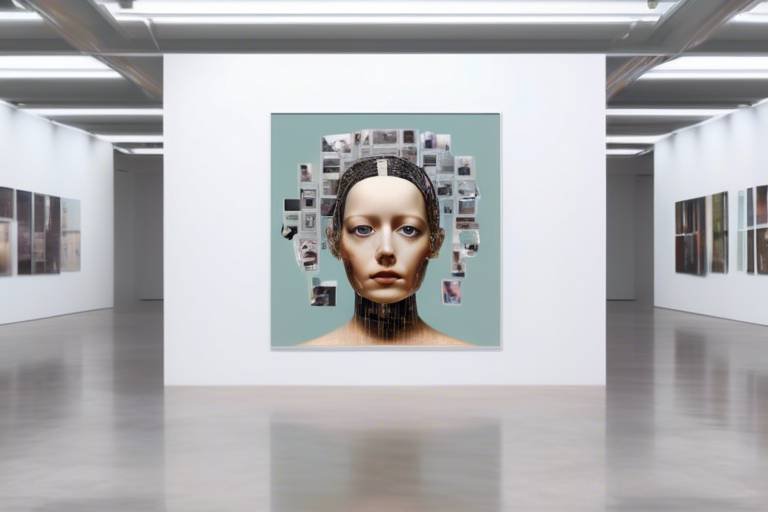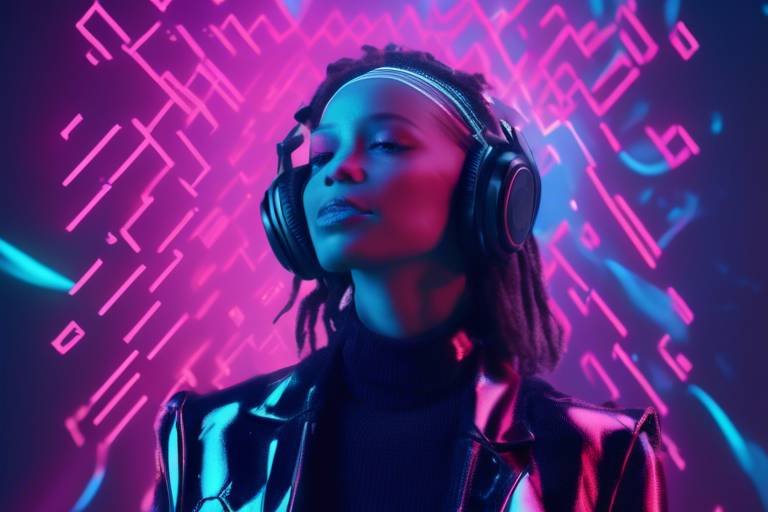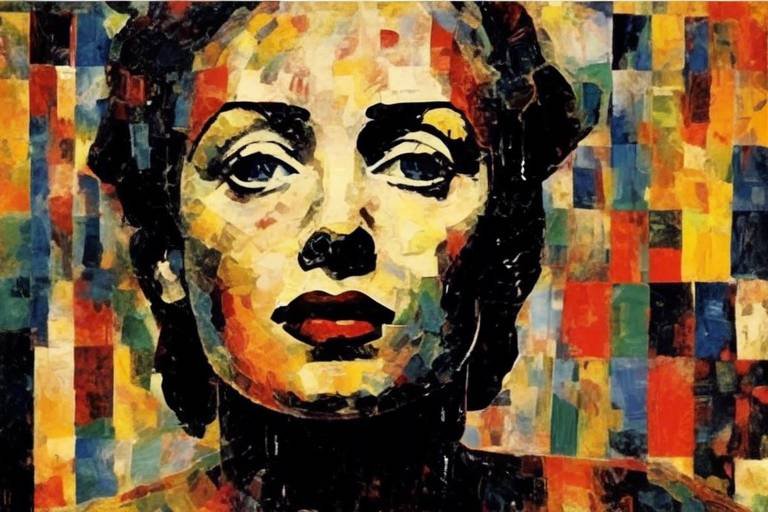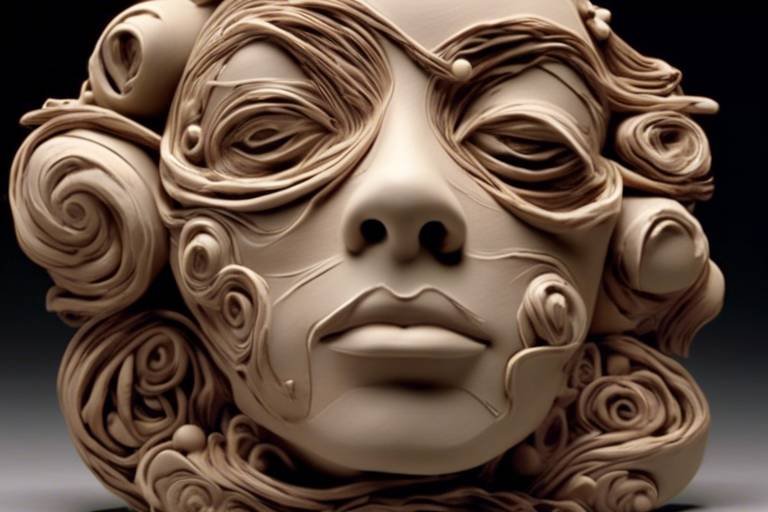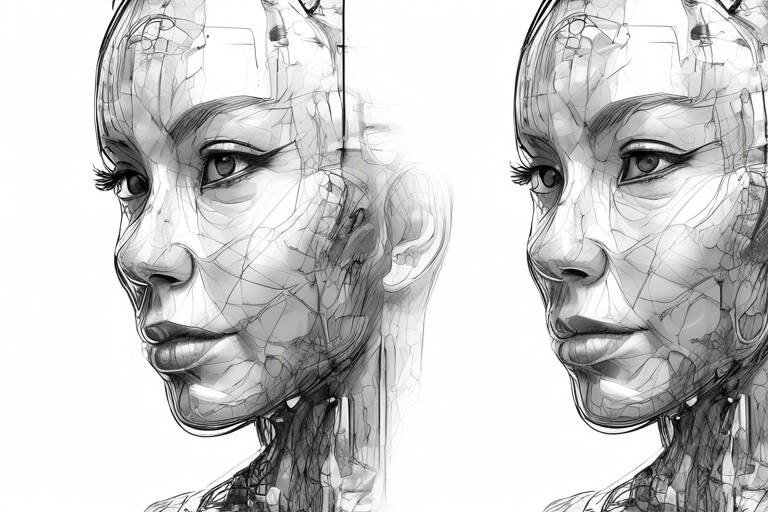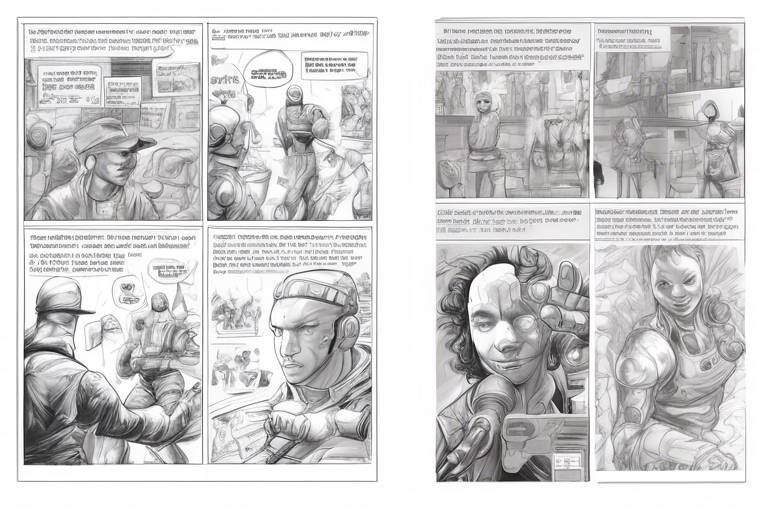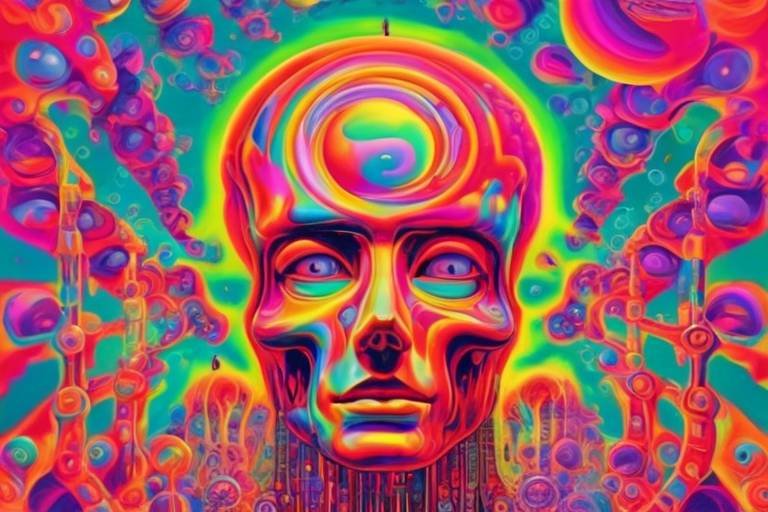Pioneering AI in the World of Graffiti
In an era where technology is reshaping every facet of our lives, graffiti art is experiencing a remarkable transformation through the lens of artificial intelligence. This intersection of creativity and technology is not just a trend; it’s a revolution that is redefining how we perceive urban art. Imagine walking down a city street, only to find that the vibrant murals you’re admiring were partially created by algorithms! The fusion of AI and graffiti is not only enhancing artistic expression but also challenging traditional notions of what art can be.
Graffiti has long been a voice of the streets, a medium for artists to express their thoughts, emotions, and social commentary. However, with the advent of AI, this age-old form of expression is being infused with new life. Artists are now harnessing the power of machine learning to push the boundaries of their creativity. But how exactly does AI fit into the world of graffiti? Let's dive into this fascinating realm where technology meets art.
As we explore this topic, we’ll uncover the various ways AI is influencing graffiti artists. From algorithmic art creation to interactive installations, the possibilities seem endless. Artists are beginning to see AI not merely as a tool, but as a collaborator that can inspire fresh ideas and innovative techniques. This partnership is akin to having a creative buddy who offers suggestions, nudges you in new directions, and helps you break through creative blocks. How exciting is that?
Moreover, the implications of AI in graffiti extend beyond individual artists. They ripple through the urban landscape, altering how communities engage with public art. With AI, graffiti can become a participatory experience, inviting audiences to take part in the creative process. Imagine a world where anyone can contribute to a mural through an interactive app, creating a living canvas that evolves over time. This is not just a dream; it’s a glimpse into the future of graffiti.
As we navigate this brave new world, it’s essential to consider the ethical implications that accompany such advancements. Questions of authorship, originality, and the impact on traditional graffiti artists are at the forefront of this discussion. What does it mean for an artist to share their creative space with an algorithm? Are we diluting the authenticity of graffiti, or are we enhancing it? These are critical questions that will shape the future of this art form.
In this article, we will delve deeper into the evolution of graffiti, the role of AI in modern art, and the exciting future that lies ahead. We’ll also highlight notable case studies where AI has collaborated with human creativity, showcasing projects that blend technology with traditional techniques. So, buckle up as we embark on this journey through the dynamic world of graffiti and artificial intelligence!
- What is AI-generated graffiti? AI-generated graffiti refers to artworks created or assisted by artificial intelligence algorithms, allowing for unique styles and techniques that may not be achievable by human artists alone.
- How can AI enhance traditional graffiti? AI can provide artists with new tools for creativity, generate design ideas, and facilitate interactive experiences that engage the community in the graffiti creation process.
- Are there ethical concerns regarding AI in graffiti? Yes, concerns include issues of authorship, originality, and the potential displacement of traditional graffiti artists as AI becomes more integrated into the creative process.
- Can anyone participate in AI graffiti projects? Many AI graffiti projects are designed to be inclusive, allowing community members to engage and contribute to the art, making it a shared experience.

The Evolution of Graffiti
Graffiti is not just a modern phenomenon; it is a rich tapestry woven through the fabric of history, reflecting societal changes, cultural movements, and the voices of the marginalized. Its roots can be traced back to ancient civilizations, where symbols and markings were used to communicate messages, commemorate events, or simply express identity. For instance, ancient Egyptians adorned their tombs with intricate hieroglyphics, while the Romans left their mark on city walls with political slogans and personal declarations. This early form of graffiti served as a precursor to what we now recognize as street art.
Fast forward to the 20th century, where graffiti began to evolve into a recognized art form. The 1960s and 1970s saw the rise of tagging in urban centers like New York City, where artists sought to claim their space and make a statement. This was more than just vandalism; it was a form of rebellion against social norms and a way to assert one's identity in a rapidly changing world. The emergence of hip-hop culture played a significant role in this evolution, giving birth to a vibrant community of artists who used spray cans as their brushes and city walls as their canvases.
As graffiti gained popularity, it began to attract attention from the mainstream art world. The 1980s brought about a shift where graffiti transitioned from the streets to galleries, with artists like Jean-Michel Basquiat and Keith Haring bringing street art into the limelight. Their works challenged traditional notions of art, emphasizing that creativity could flourish outside conventional settings. This period marked a significant turning point, as graffiti began to be recognized not just as a form of expression, but as a legitimate art form deserving of appreciation and scholarly attention.
Today, graffiti continues to evolve, influenced by various factors including technology, social media, and global communication. The rise of the internet has allowed artists to share their work with a broader audience, transcending geographical boundaries. Social media platforms like Instagram and TikTok have become essential tools for graffiti artists, enabling them to showcase their creations and connect with fans worldwide. This digital revolution has also led to the emergence of new styles and techniques, as artists experiment with augmented reality and interactive installations.
In this context, it's essential to recognize the impact of community and collaboration in the evolution of graffiti. Artists are increasingly working together to create larger murals and installations, fostering a sense of unity and shared purpose. These collaborations often reflect the diverse backgrounds and experiences of the artists involved, resulting in powerful visual narratives that resonate with the public.
As we look to the future, graffiti will undoubtedly continue to evolve, influenced by technological advancements and changing societal norms. The blending of graffiti with artificial intelligence is just one example of how this art form is adapting to the modern world. It raises intriguing questions about the nature of creativity and the role of the artist in an increasingly digital landscape.
In summary, the evolution of graffiti is a testament to its resilience and adaptability. From ancient markings to contemporary street art, it has always been a reflection of the human experience, capturing the essence of society at various points in time. As we embrace the future, graffiti will continue to challenge perceptions, inspire dialogue, and transform urban landscapes around the globe.

AI's Role in Modern Art
In today's rapidly evolving artistic landscape, artificial intelligence (AI) is carving out a unique niche, transforming how we create, perceive, and interact with art. The integration of AI into modern art practices, particularly in graffiti, is not just a trend; it's a revolution. Imagine walking through a city where the walls are alive with art that changes based on your emotions or the time of day. This is the kind of future that AI is helping to shape.
AI's influence on contemporary art is profound. Artists are increasingly using algorithms and machine learning to push the boundaries of their creativity. But how does this work? At its core, AI analyzes vast amounts of data, learning patterns and styles from existing artworks. This capability allows it to generate unique designs that can inspire artists or even serve as collaborative partners in the creative process. For instance, graffiti artists can input their own styles into an AI system, which then produces variations that they might not have considered. This symbiosis between human creativity and machine learning opens up a world of possibilities.
One fascinating aspect of AI in art is the concept of algorithmic art creation. This involves using coded algorithms to create designs that are not only visually appealing but also innovative. Artists can experiment with different parameters, allowing for a level of creativity that feels limitless. The results can range from stunning visuals that capture the essence of urban life to abstract pieces that challenge our perceptions of reality. It's like having a collaborative partner that never runs out of ideas!
Several notable projects exemplify the successful collaboration between AI and human artists. For example, the project "DeepArt" uses neural networks to transform photographs into artworks reminiscent of famous painters. In the graffiti realm, artists like Robbie Barrat have explored the use of AI to create striking murals that blend traditional techniques with modern technology. These projects are not just about aesthetics; they raise important questions about authorship and originality in art. Who is the true artist—the human or the algorithm?
As we delve deeper into the role of AI in art, we must also confront ethical dilemmas. Issues surrounding authorship and originality come to the forefront. If an AI generates a piece of art, who holds the rights to that creation? Is it the programmer, the artist who inspired the AI, or the machine itself? These questions challenge our traditional notions of creativity and ownership, sparking debates that are essential for the future of art in the AI era.
Furthermore, the potential impact on traditional graffiti artists cannot be overlooked. While AI offers exciting new tools for creativity, it also poses a risk of overshadowing the human element of art. The essence of graffiti has always been about personal expression, often rooted in cultural and social commentary. As AI takes a more prominent role, maintaining the authenticity and voice of traditional artists becomes crucial.
Another exciting avenue where AI is making waves is in interactive graffiti experiences. These installations invite audiences to engage with art in a dynamic way, breaking down the barriers between creator and viewer. Imagine a wall that reacts to your movements or emotions, allowing you to become part of the artwork itself. This interactivity not only enhances the viewer's experience but also democratizes art, making it accessible to everyone, regardless of their artistic background.
As we look to the future, the role of AI in modern art, particularly graffiti, is set to expand even further. The fusion of technology and creativity will likely lead to new trends and forms of expression that we can't yet imagine. With AI as a tool, artists can explore uncharted territories, creating works that challenge perceptions and provoke thought. The future of graffiti is not just about paint on walls; it's about the intersection of technology, community, and creativity.
- How is AI changing the way we create art? AI allows artists to experiment with new styles and techniques, generating unique designs and enhancing creativity.
- What are the ethical concerns surrounding AI in art? Issues of authorship, originality, and the impact on traditional artists are significant concerns in the integration of AI into art.
- Can AI create art independently? While AI can generate artworks, the debate about whether it can truly be considered 'art' without human input continues.
- How does interactive graffiti work? Interactive graffiti installations use AI to engage audiences, allowing them to participate in the creation process and experience art dynamically.

Algorithmic Art Creation
In the ever-evolving world of graffiti, is emerging as a revolutionary force, blending the realms of technology and creativity in ways that were once thought to be the stuff of science fiction. Imagine a canvas where the brush strokes are dictated by complex algorithms, each line and color chosen not just by the artist’s hand but also by the logic of a machine. This fascinating intersection of art and technology allows artists to push the boundaries of their creativity, exploring styles and techniques that were previously unimaginable.
At its core, algorithmic art creation involves using computer algorithms to generate unique designs and patterns. These algorithms can analyze vast amounts of data, including color palettes, shapes, and even the emotional responses elicited by different art forms. By leveraging this information, artists can create graffiti that resonates with viewers on a deeper level. It's akin to having a co-pilot in your creative journey—one that not only assists in the execution of ideas but also inspires new ones.
For instance, artists can input various parameters into an algorithm, allowing it to produce a multitude of design variations. This process enables them to experiment with different visual styles quickly, leading to unexpected and exciting results. Here are some key aspects of algorithmic art creation:
- Data-Driven Design: Algorithms can analyze trends in graffiti styles, helping artists stay relevant and innovative.
- Enhanced Creativity: By providing a new set of tools, algorithms encourage artists to step outside their comfort zones.
- Collaboration Between Human and Machine: This dynamic partnership can lead to groundbreaking projects that redefine what graffiti can be.
Moreover, the use of algorithms in graffiti art is not just about aesthetics; it also opens up discussions about authorship and originality. When a machine generates a piece of art, who owns it? Is it the artist who provided the initial input, or is it the algorithm itself? These questions challenge traditional notions of creativity and ownership, prompting artists to rethink their roles in the art-making process.
In recent years, we have witnessed several compelling projects where artists have teamed up with AI to create stunning works of graffiti. For example, the collaboration between street artists and AI-driven software has resulted in murals that change dynamically based on viewer interaction, creating a living art form that evolves with each new audience. This not only captivates onlookers but also invites them to engage with the artwork in a personal and meaningful way.
As we delve deeper into the world of algorithmic art creation, it becomes clear that the possibilities are endless. The fusion of technology and graffiti is not just a passing trend; it’s a transformative movement that is reshaping how we perceive and create art in urban spaces. With each new algorithm developed, artists are given a fresh canvas to explore, pushing the limits of their imagination and redefining the very essence of graffiti.
- What is algorithmic art creation?
Algorithmic art creation involves using computer algorithms to generate unique designs and patterns, allowing artists to experiment with new styles and techniques. - How does AI influence graffiti art?
AI can analyze trends, enhance creativity, and facilitate collaboration between human artists and machines, leading to innovative and dynamic artworks. - What are the ethical considerations of using AI in art?
Key ethical dilemmas include issues of authorship, originality, and the impact on traditional artists.

Case Studies of AI Artists
In the fascinating world where artificial intelligence meets graffiti, several case studies stand out, showcasing the incredible potential of AI as a collaborative partner for artists. One of the most prominent examples is the project known as “The Next Rembrandt.” Although it primarily focuses on painting, it illustrates how AI can analyze the works of masters and create new pieces that mimic their style. This project used deep learning algorithms to study Rembrandt’s techniques, color palettes, and compositions, ultimately generating a new painting that could easily be mistaken for an original. The implications of such technology in graffiti art are profound, as it opens up avenues for artists to explore styles and techniques that were previously thought to be solely human.
Another compelling case is the collaboration between graffiti artist Fintan Magee and AI technology. Magee, known for his large-scale murals, experimented with a neural network to create a piece that reflected both his artistic vision and the capabilities of AI. By feeding the algorithm images of his past works, the AI generated new concepts that Magee then brought to life on a wall in Melbourne. This fusion of human creativity and artificial intelligence not only resulted in a stunning visual piece but also sparked conversations about the nature of creativity itself.
Moreover, the project “AI Graffiti” involved a group of artists collaborating with AI to create interactive street art. The AI was programmed to respond to environmental factors such as weather, time of day, and even social media trends, altering the graffiti in real-time. This dynamic approach to graffiti art not only engages the audience but also reflects the ever-changing nature of urban environments. It poses an intriguing question: can art be truly alive if it evolves continuously?
These case studies illustrate a broader trend where artists are not merely using AI as a tool but are instead embracing it as a collaborator. The dialogue between human and machine leads to innovative results that challenge our perceptions of authorship and originality in art. As technology continues to advance, we can expect to see more artists pushing the boundaries of creativity through their partnerships with AI.
While the collaboration between AI and artists yields exciting outcomes, it also raises important questions about the future of graffiti art. How will these technological advancements influence traditional techniques? Will the essence of graffiti, often rooted in rebellion and individual expression, be diluted by algorithms? As we explore these case studies, it becomes clear that AI is not just a tool; it is a transformative force in the world of graffiti, reshaping how we think about art and creativity.
- What is AI graffiti? AI graffiti refers to the use of artificial intelligence technologies to create, enhance, or interact with graffiti art.
- Can AI create original graffiti? Yes, AI can generate unique graffiti designs by analyzing existing styles and producing new concepts, but the debate over authorship remains.
- How does AI influence traditional graffiti artists? AI can provide new tools and techniques for traditional artists, allowing them to experiment and innovate, but it also raises concerns about the authenticity of their work.
- Are there ethical concerns with AI in graffiti? Yes, issues such as originality, authorship, and the potential commercialization of street art are significant ethical considerations.

Ethical Considerations
As we delve into the vibrant world of graffiti enhanced by artificial intelligence, it becomes crucial to address the that arise from this fusion of technology and art. The integration of AI into creative practices stirs a pot of questions about authorship, originality, and the very essence of what it means to be an artist. When an algorithm generates a piece of graffiti, who is the true creator? Is it the artist who programmed the AI, the AI itself, or the original inspiration that fueled the design? These questions challenge our traditional notions of creativity and ownership.
Moreover, the use of AI in graffiti can lead to concerns over cultural appropriation. As algorithms learn from vast datasets that include diverse artistic styles, there’s a risk that they might inadvertently borrow elements from cultures without proper context or respect. This raises the question: how do we ensure that AI-generated art honors the traditions and narratives of the communities it draws from?
Another significant issue is the potential impact on traditional graffiti artists. As AI tools become more accessible, there's a fear that the market could become saturated with AI-generated works, overshadowing the unique voices of human artists. Imagine a world where the streets are filled with stunning, algorithmically generated murals that, while visually captivating, lack the personal touch and emotional depth that comes from human experience. This might lead to a homogenization of graffiti art, where the individuality of artists is lost in a sea of digital creations.
To navigate these ethical waters, it’s essential to establish guidelines that promote responsibility and respect in the use of AI in graffiti. Artists and technologists alike must engage in conversations about the implications of their work, ensuring that they are not only pushing artistic boundaries but also honoring the rich history and cultural significance of graffiti. Collaboration between human artists and AI should be seen as a partnership rather than a replacement, where both parties contribute to the creative process.
In conclusion, as graffiti continues to evolve with the aid of AI, the conversations around ethics must keep pace. By addressing these challenges head-on, we can pave the way for a future where technology enhances rather than diminishes the artistic landscape. The dialogue surrounding authorship, appropriation, and the role of AI in creativity is not just necessary; it is vital for the integrity of graffiti as an art form.
- What is the main ethical concern regarding AI and graffiti? The primary concern revolves around authorship and originality, questioning who is the true creator of AI-generated art.
- Can AI lead to cultural appropriation in graffiti? Yes, there is a risk that AI may borrow styles from various cultures without proper context, leading to ethical dilemmas.
- How might AI impact traditional graffiti artists? AI could potentially saturate the market with generated works, overshadowing the unique expressions of human artists.
- What should artists consider when using AI in their work? Artists should engage in discussions about the implications of AI, ensuring respect for cultural narratives and the integrity of their art.

Interactive Graffiti Experiences
In the fast-paced world of art, the fusion of technology and creativity has given birth to some truly that redefine how we engage with urban art. Imagine walking through a bustling city street, where the walls are not just blank canvases but vibrant, living artworks that respond to your presence. This is not a distant dream; it’s happening right now! Artists and technologists are collaborating to create immersive installations that invite the public to participate in the creative process, turning passive viewers into active contributors.
One of the most exciting aspects of these interactive experiences is the use of augmented reality (AR) and virtual reality (VR). Through the lens of a smartphone or VR headset, spectators can see layers of graffiti that are invisible to the naked eye. This technology allows users to interact with the artwork in real-time, altering colors, shapes, and patterns with simple gestures. Picture this: you point your device at a wall, and suddenly, the static graffiti comes alive, morphing into a dynamic display that tells a story or reacts to your movements. It’s like stepping into a painting where you control the brush strokes!
Moreover, some installations utilize machine learning algorithms that adapt based on audience engagement. For example, in a recent project in Berlin, an AI-driven graffiti wall analyzed the emotions of passersby using facial recognition technology. Depending on the mood detected, the wall would change its colors and designs, creating a unique experience for each viewer. This level of interaction not only captivates the audience but also challenges traditional notions of authorship and creativity in art.
These interactive experiences are not just about technology; they also foster a sense of community. Many projects encourage collaboration among artists and spectators, often resulting in collective murals that reflect the diverse voices of the community. For instance, workshops hosted in urban spaces invite locals to contribute their ideas and designs, which are then transformed into stunning graffiti pieces through the help of AI tools. This collaborative spirit breathes new life into the urban landscape, making art a shared experience rather than a solitary one.
As we look to the future, it’s clear that interactive graffiti experiences will continue to evolve. With advancements in technology, the possibilities are endless. Imagine a future where you could walk through a city and leave your mark on a digital graffiti wall, which could then be projected onto physical surfaces, creating a blend of digital and traditional art forms. The intersection of AI and graffiti not only enhances artistic expression but also democratizes the art world, allowing everyone to have a voice in the creative process.
In conclusion, interactive graffiti experiences are reshaping our understanding of art in public spaces. They invite us to engage, collaborate, and create in ways that were once unimaginable. As technology continues to advance, we can only anticipate the exciting developments that lie ahead in the vibrant world of graffiti art.
- What is interactive graffiti? Interactive graffiti refers to art installations that allow viewers to engage with the artwork, often using technology like AR or VR to enhance the experience.
- How does AI contribute to graffiti art? AI can analyze audience reactions and adapt the artwork in real-time, creating a dynamic and personalized experience for each viewer.
- Can anyone participate in creating interactive graffiti? Yes! Many projects encourage community involvement, allowing people to contribute their designs and ideas.
- What are the benefits of interactive graffiti experiences? These experiences foster community engagement, promote collaboration among artists and spectators, and make art more accessible to the public.

The Future of Graffiti with AI
As we stand on the brink of a new era in the art world, the fusion of artificial intelligence and graffiti is not just a passing trend; it's a revolution that is set to redefine urban landscapes and creative expression. Imagine walking through a city where the walls are alive with ever-changing designs, all generated by AI algorithms that respond to the environment, the time of day, or even the emotions of passersby. This is not science fiction; it's the future of graffiti, and it's coming faster than you might think.
The integration of AI into graffiti art opens up a plethora of possibilities. Artists can now leverage technology to explore new dimensions of creativity. With the help of machine learning, graffiti can evolve in real-time, allowing for a dynamic interaction between the artist, the AI, and the audience. For instance, an artist might input a few basic parameters into an AI program, and the AI could generate a stunning mural that reflects the artist's style but introduces unexpected elements that push traditional boundaries.
Furthermore, AI can facilitate collaboration among artists like never before. Imagine a platform where graffiti artists from around the world can connect, share their AI-generated designs, and even co-create murals in virtual spaces. This kind of community-driven approach could lead to a renaissance of graffiti art, fostering a sense of belonging and shared purpose among artists. As artists collaborate with AI, they can also engage with their audiences in innovative ways, inviting them to contribute ideas or vote on designs, thus making the creation process more inclusive and interactive.
However, with great power comes great responsibility. As graffiti art continues to evolve with AI, it's crucial to consider the ethical implications. Questions surrounding authorship and originality will become increasingly complex. Who owns a piece of art created by an AI algorithm? The artist who programmed the AI, the AI itself, or the community that contributed to its design? These questions will challenge our traditional notions of creativity and ownership in the art world.
Moreover, the preservation of graffiti art is another area where AI can play a pivotal role. Given the transient nature of graffiti, with many pieces being painted over or fading away, AI can help document and archive these artworks. Advanced imaging technologies and AI algorithms can create detailed records of murals, ensuring that even the most fleeting pieces of art are preserved for future generations. This not only honors the artists but also provides a historical context for the evolution of graffiti as an art form.
In summary, the future of graffiti with AI is not just about technology; it's about transforming creativity and community engagement. As we embrace these innovations, we may witness a shift in how graffiti is perceived—moving from vandalism to a celebrated form of artistic expression. The walls of our cities could soon become canvases of collaboration, emotion, and endless creativity, reflecting the vibrant pulse of urban life.
- How is AI changing the way graffiti is created? AI allows artists to experiment with new styles and techniques, generating unique designs that can evolve in real-time.
- What are the ethical concerns related to AI in graffiti? Issues of authorship and originality arise, questioning who owns the rights to AI-generated art.
- Can AI help preserve graffiti art? Yes, AI can document and archive graffiti, ensuring its recognition and appreciation for future generations.
- Will AI replace traditional graffiti artists? Rather than replacing artists, AI serves as a tool that enhances creativity and fosters collaboration.

Community and Collaboration
In the vibrant world of graffiti, community and collaboration have always played a pivotal role. With the advent of artificial intelligence, these elements are being amplified in ways that were previously unimaginable. Imagine a canvas where artists from different corners of the globe can come together, share ideas, and create stunning works of art collaboratively. This is not just a dream; it's becoming a reality thanks to AI-powered platforms that facilitate interaction among artists.
AI tools are breaking down geographical barriers, allowing graffiti artists to connect and collaborate in real-time. For instance, platforms like Graffiti Generator and Artivive enable artists to upload their designs, which can then be transformed using AI algorithms into unique pieces that blend various styles. This not only fosters a sense of community but also encourages artists to step out of their comfort zones and explore new creative avenues. The result? A rich tapestry of graffiti that reflects a multitude of influences and perspectives.
Moreover, AI can help in organizing collaborative projects that unite artists for a common cause. Whether it’s a mural celebrating local culture or a piece addressing social issues, AI can streamline the planning process by providing tools for project management and communication. For example, artists can use AI-driven platforms to brainstorm ideas, vote on designs, and even schedule painting sessions. This level of organization can lead to more cohesive and impactful artworks that resonate with the community.
Additionally, interactive installations powered by AI are further enhancing community engagement. Imagine walking through a city street and coming across a digital wall where anyone can contribute their graffiti ideas. Through AI, these contributions can be instantly visualized, allowing for a dynamic and ever-evolving piece of art. This not only democratizes the art-making process but also invites the public to participate in the creative journey, fostering a deeper appreciation for graffiti as a legitimate art form.
As graffiti continues to evolve with AI, the potential for community-driven projects is limitless. Artists can collaborate with local organizations to create murals that tell the stories of their neighborhoods, or they can engage with schools to inspire the next generation of graffiti artists. The fusion of technology and traditional art forms is not just reshaping urban landscapes; it’s building bridges between communities, fostering understanding, and celebrating diversity.
In conclusion, the intersection of AI and graffiti is not merely a technological advancement; it’s a movement towards inclusivity and collaboration. As artists harness the power of AI, they are not just creating art; they are forging connections, building communities, and inspiring change. The future of graffiti is bright, and with AI as a partner, the possibilities for collaboration are endless.
- How is AI impacting graffiti art?
AI is transforming graffiti by enabling artists to collaborate more easily, experiment with new styles, and engage with their communities in innovative ways. - Can anyone participate in AI-driven graffiti projects?
Yes! Many AI platforms encourage public participation, allowing individuals to contribute their ideas and designs to collaborative artworks. - What are the ethical considerations of AI in graffiti?
Ethical issues include questions of authorship, originality, and the potential impact on traditional graffiti artists, as AI-generated art becomes more prevalent. - How can AI help preserve graffiti art?
AI can document and archive graffiti works, ensuring that this ephemeral art form is recognized and appreciated for future generations.

Preservation of Graffiti Art
Graffiti, often seen as a fleeting form of expression, presents a unique challenge when it comes to preservation. Unlike traditional artworks that can be housed in galleries, graffiti is typically painted on public walls, exposed to the elements and the whims of urban development. This impermanence raises an important question: how can we ensure that these vibrant expressions of culture and creativity are not lost to time? Enter artificial intelligence, a game changer in the world of art preservation.
AI technologies are being harnessed to document and archive graffiti art in ways that were once unimaginable. Through advanced imaging techniques and machine learning algorithms, AI can create detailed records of graffiti murals, capturing their intricate details and colors. This digital preservation allows for the creation of virtual galleries where the public can explore and appreciate graffiti art without the constraints of physical space. Imagine walking through a digital museum, where every wall tells a story, and every piece of art is just a click away!
Moreover, AI can analyze trends in graffiti styles and themes over time, providing valuable insights into the cultural and social contexts that shape this art form. By studying the data collected from various locations, AI can help researchers understand how graffiti evolves, reflecting societal changes and movements. This not only aids in academic research but also enhances the appreciation of graffiti as a legitimate art form.
In addition to documentation, AI can assist in the restoration of graffiti artworks that have been damaged or faded. Using techniques such as image reconstruction, AI can help recreate lost elements of a mural, allowing it to be restored to its original glory. This not only preserves the artwork but also honors the artist's intent, ensuring that their message continues to resonate with future generations.
However, the preservation of graffiti through AI does raise some ethical questions. For instance, who owns the digital records of a graffiti piece? Is it the artist, the city, or the technology company that developed the software? These are crucial issues that need to be addressed as we navigate the intersection of technology and art.
In conclusion, the preservation of graffiti art through AI not only safeguards these vibrant expressions of culture but also elevates them to a level of recognition they deserve. As technology continues to evolve, it opens up new avenues for preserving the ephemeral nature of graffiti, ensuring that these fleeting moments of creativity are captured for posterity. The future of graffiti preservation looks promising, and it’s an exciting time for both artists and enthusiasts alike!
- How does AI help in the preservation of graffiti? AI technologies can document, archive, and even restore graffiti artworks using advanced imaging techniques and machine learning algorithms.
- Can AI recreate lost graffiti art? Yes, AI can use image reconstruction techniques to help restore damaged or faded graffiti to its original state.
- Who owns the digital records of graffiti art? Ownership of digital records can be complex and is often contested between the artist, the city, and the technology developers.
- Is graffiti considered a legitimate art form? Yes, graffiti is increasingly recognized as a legitimate form of artistic expression, reflecting cultural and social commentary.
Frequently Asked Questions
- What is the relationship between AI and graffiti art?
AI is revolutionizing graffiti art by providing artists with innovative tools to create unique designs. This technology allows for the generation of new styles and techniques, pushing the boundaries of traditional graffiti.
- How has graffiti evolved over the years?
Graffiti has a rich history that dates back to ancient civilizations. It has transformed from simple markings into a recognized modern art form, influenced by social changes and cultural movements throughout the ages.
- Can AI create graffiti independently?
Yes, AI can generate graffiti designs through algorithms and machine learning. However, the most exciting results come from collaborations between AI and human artists, where both contribute to the creative process.
- What are some ethical concerns regarding AI in graffiti?
There are several ethical dilemmas, including questions of authorship and originality. As AI-generated art becomes more prevalent, it challenges the traditional notions of creativity and the role of the artist.
- How does AI enhance interactive graffiti experiences?
AI technology can create interactive installations that allow audiences to engage with graffiti art in real-time. This interactivity makes the art experience dynamic and participatory, breaking down barriers between the artist and the viewer.
- What does the future hold for graffiti with AI?
The future of graffiti art is likely to see even more integration of AI technologies. We can expect new trends in artistic expression, as well as changes in how artists collaborate and share their work through digital platforms.
- How can AI help preserve graffiti art?
AI can assist in the documentation and preservation of graffiti by creating digital records of artworks. This ensures that ephemeral pieces are recognized and appreciated long after they have faded from their physical locations.
- Are there any notable projects that combine AI and graffiti?
Yes, there are several innovative projects where AI has collaborated with graffiti artists. These projects showcase the fusion of technology and traditional art, resulting in unique and exciting creations.
- How can graffiti artists benefit from using AI?
Graffiti artists can leverage AI to explore new creative avenues, enhance their artistic skills, and connect with a broader audience. AI tools can inspire new ideas and streamline the creative process, making art more accessible.


